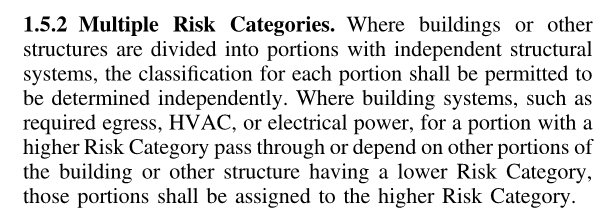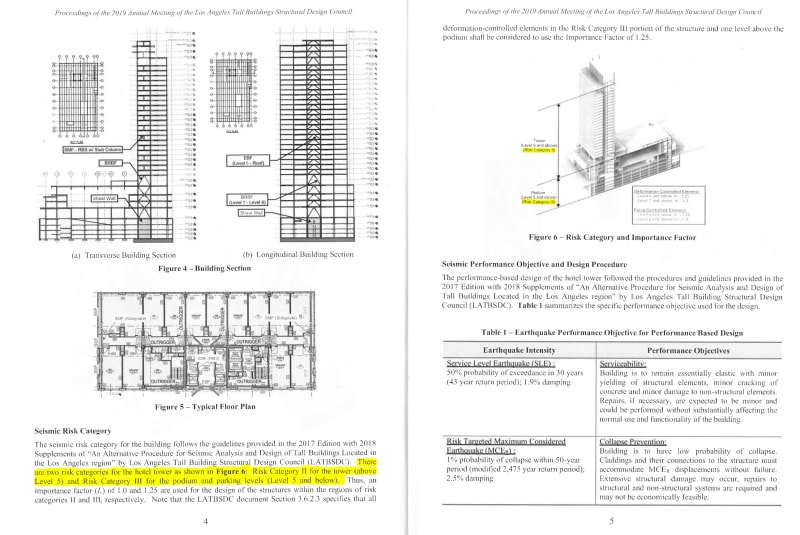Having spent some more time noodling on this, I have these additional thoughts:
1) Here, I'll elaborate a bit more on the wind example that I mentioned previously. It'll become clear why further on. In a previous design iteration, the building was a fair bit taller and had a true outrigger system comprising story high CIP walls that reached out from the central core to grab outrigger columns. As one would expect, those outrigger floors were placed well above the lower, risk category III occupancy levels. This was really where our concern originated with respect to the appropriate risk category business. With this setup, a cat III event acting over the entire building would compromise the outriggers located on the cat II levels.
And, once the outriggers were compromised in this way, it would be difficult to argue that the lateral system for all levels of the building would not be compromised. Composite action between the core and the outriggers would be lost and you'd have a very different set of forces in the lower level walls and, in particular, in the foundations. So, in this instance, it makes sense to me that the lateral system of the entire building ought to be designed to cat III unless it can somehow be demonstrated that, during a cat III event, the building would still be viable without the outriggers providing the connection required for composite behavior among the various elements of the intended lateral system.
SonOfAtkins said:
I think this makes sense, intuitively. It's of little consequence to the office below that some coupling beams or slab outriggers in the tower went to 6% rotations instead of 5%, or that the tower drifted 3% instead of 2.4%. We aren't designing a post disaster facility - there is no expectation of damage-free performance.
2) I disagree and see this as being quite analogous to #1. All of the elements that you mentioned are the very ones that will be producing a degree of composite flexural behavior in your lateral system. And, as with my wind outrigger example, it cannot be said cavalierly that the assumed composite behavior of the lateral system in the Cat III levels will not depend on the integrity of the structural elements up in the cat II levels that help to provide that composite behavior.
If a coupling beams's curvature level would render it no longer fit for purpose during a cat III event, then it seems rational to me that that beam's contribution to composite action of the entire lateral system ought to be discounted as well. Of course, if you've got 200 coupling beams in the cat II tower and only four of them would see excessive damage, then a sound argument surely
could be made for allowing that to happen.
Agent666 said:
Surely part of life safety for someone in the podium is the assurance that the tower isn't going to come down on top of them...
SonOfAtkins said:
Regarding your hypothetical, consider these scenarios...
3) I agree with Agent's reasoning on this and, frankly, I believe that it probably
should apply to an independent, cat II tower constructed next to a shorter, cat III building. That said, I also find SOA's hypotheticals to be salient examples which make it abundantly clear that this is not what we
are doing regardless of what we
ought to be doing. This may ultimately just be a mater of practicality. The logistics of making one, cat II building owner design his building to a higher standard such that it not collapse on a current, or even future, neighboring cat III building would surely get a bit nuts. Lastly, the LATBSDC tower/podium example makes it clear that we're also not to be worried about cat II towers collapsing upon cat III podiums during cat III events.
4) I read into the LATBSDC docs a bit last night and, as a result, need to change my answer on whether or not you'll be able to sell a dual risk category tower to your peer review panel. Based on what I've seen in the LATBSDC, docs, I think that you've got a legitimate shot. I can only think of one thing that makes the LATBSDC examples a bit different from yours and it is, admittedly, a reach. In general, a podium will possess lateral resisting systems separate, and in addition to the lateral systems coming down from the tower(s). As such, tower collapse excepted, a loss of lateral system composite behavior in level is probably not as much of a concern as it might be when the podium level lateral systems are really just vertical extensions of the tower lateral systems. I didn't see anything in the LATBSDC docs that specifically mentioned this aspect of things however.
So yeah, I now think that you've got a pretty good shot at being able to push this through. At the least, hopefully the extra vetting here will help you to cut your teeth one the problem and be better prepared to answer any objections that may be voiced.


